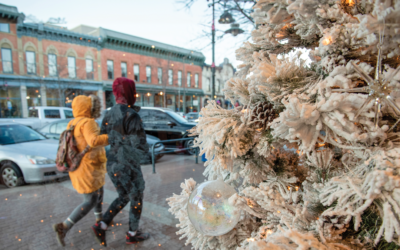Photos by Jared Fiel and Poudre Wilderness Volunteers
Volunteers help bring back areas destroyed by Cameron Peak fire
Taylor Weisshaar, Pete Knox and Steve Berenson are the muscle. Bob Manuel, at 74, has 20 years of experience restoring trails throughout Roosevelt National Forest. He is the brains of the operation.
“Think of it like a giant jigsaw puzzle,” he says after climbing like a mountain goat on knees that have been surgically repaired eight times.
The three young men holding the 100-pound rock look at him blankly. None of them has ever repaired a trail before, but all three were brought out on this gorgeous Sunday morning to the Big South Trail as part of the Poudre Wilderness Volunteer program, to help reopen many of the trails closed due to last year’s Cameron Peak Fire, which burned over 208,000 acres, the largest wildfire in Colorado’s history.
The fire burned 122 of the 286 miles of trails maintained by the Canyon Lakes Ranger District out of Fort Collins, which is where the Poudre Wilderness Volunteers have worked for more than 25 years. A total of 42 miles of those 57 trails are considered severely burned and most of them are closed and will be for years.
Some of the work is clearing fallen or burned trees. Some of the work is rebuilding bridges. And some of it comes to building back the trails that have been washed out by erosion or destroyed because the fire was so hot it literally made the rocks holding up the trail crack and fall away. And restoring those trails is no easy task. Just ask the muscle.
“I figured we would be clearing a lot of trees, but this is fun,” Weisshaar says. Earlier in the day when the crew leaders were picking teams, Manuel pointed at Weisshaar. “He told me I was a rock guy. I don’t know if that’s a compliment.”




They just do as they were told, which means hiking farther up the trail to an area where there are lots of rocks up on the side of the hill. These would be those heavy puzzle pieces Manuel would have them collect.
The crew used bars, shovels and an ingenious device made of rope and chain, called an “Austin,” to get the rocks down the hill to the trail. Four of them loaded one of the bigger rocks into the Austin and used the long rock bars to carry it down to the fix area.

Last year was just devastating. I just wanted to find a way to help out.
“That’s called man-handling,” Manuel says when he sees her trailing the rest of the group.
“I’ve never felt so manly,” she says after she plops the rock on a pile and turns to go for another load.
As she is walking up for more, she reflects on the work. “I have a new appreciation for what is here,” she says. “Now when I see a rock field on a hike, I am going to be looking for ones to use later.” Manuel adds, “You will never walk a trail the same way again.”
Manuel started with the group 20 years ago at the request of a friend who worked with him at Woodward Governor in Fort Collins. He tells you he does this because he loves the outdoors and tells you to look around and admire the beauty of where he gets to work. But if you pry a little, you find his real motivation for doing this for so long. “When I was younger, I had a Jeep and then later a Land Cruiser and I really tore the hell out of stuff,” he says. “I look at this as helping bring back some of it. And I still have a ways to go to make up for it.”
Berenson agrees. “We have been hiking all over since we got here, and Cat found this opportunity and it’s great. I just showed up and they gave me a big pole and I’m good to go,” he says. “This is probably the kind of area we would be in anyway on a Sunday.” But just not with a big pole. “But now I might have to get me one,” he adds.
“We just figure this is the least we could do,” says McAteer. “We have driven by here a million times and never stopped, but now I want to come back when this finally opens. It’s gorgeous here.” Knox says he has been teaching his kids about trails when he takes them on hikes. “I knew a little before I came out here,” he says. “But now I think I can actually answer some of their questions.”
Many of those questions may involve this mysterious puzzle Manuel keeps talking about. The young men are slowly getting it though. “You have to turn the rock 100 different ways to get it to fit,” Manuel explains.
The crew members all gather in the shade and drink plenty of water. Manuel pops up from the side of the trail with the energy of a teenager, walks past the resting “muscle” and says, “Ok, now let’s get to the next one.”

WHO ARE THE POUDRE WILDERNESS VOLUNTEERS?
Volunteers act as volunteer rangers on the trails, answering questions from inquisitive visitors. They also survey trails, remove trees, repair bridges and restore trails after major events.
With more than 300 volunteers, PWV is one of the largest groups of this kind in the country, according to Chair Mike Corbin, who retired years ago from NASA and the space shuttle program. “I didn’t want to just sit around in retirement and now I’m like a Boy Scout again.”
The Cameron Peak Fire has increased the need for people and money to help bring the trails back to life. In a normal year, PWV would remove 1,500 to 2,400 trees off the trails. “Trees are the No. 1 thing that destroy trails,” Corbin says. This year, volunteers have already removed 2,200 trees and they have at least 8,000 more to go.
After the High Park Fire in 2012, PWV also had to rebuild eight bridges—two of which were destroyed again the next year in the floods of 2013. Cameron Peak was more than double the size of High Park. Crews have not even assessed exactly how many bridges will need to get rebuilt from this.
Volunteers have been focused on trees and now work on rebuilding the trails to avoid more erosion in these fragile areas.
This year, PWV started a GoFundMe campaign called “Reopen You Favorite Trails.” The goal was $25,000 and they raised more than $47,000 from 34 different Colorado counties, 15 states and several other countries. Corbin says the U.S. Forest Service also got money to help with the drainage in the area. The plan is to use all the federal money first and then use the campaign money to fill in the gaps.
On top of that, they have had volunteer weekends inJune and July that were completely booked with 40-50 volunteers when on a normal year, they get maybe half that.
PWV’s Jeff Randa says the concern now is that the excitement to help out and give money is at its height because the memory of the Cameron Peak Fire is fresh in people’s minds. “But it is going to take many years to come back from this,” he says.
Randa is hoping that the volunteerswill catch the bug to keep helping. Also, companies New Belgium, Odells, Nutrien and many local churches are organizing outings for their employees and members to help PWV as well.
“We need to keep this going. We need mojo for next year,” Randa says.
Related Articles
Festive Outdoor Outings
There are plenty of families in Northern Colorado who don’t want an epic adventure, or to take out a loan to go skiing, but still want to spend some chilly days outside.
Going Out on a Limb
Logging competitors chop wood for sport
Bear Basics from an Old Grizzly
A firsthand experience learning about black bears—and signs that they’re near







